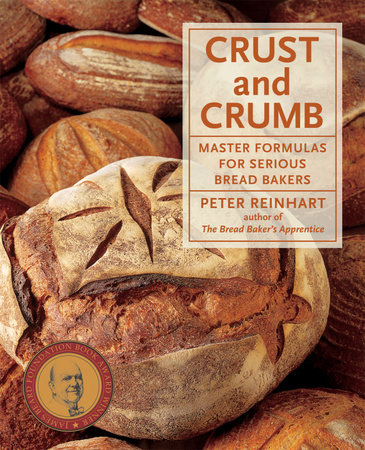Excerpt
Crust and Crumb
IntroductionThe Bread RevolutionMany people are intimidated by the process of making bread, especially sourdough, or as I prefer to call it, wild yeast bread. The thought of nurturing a container of living, bubbling dough, feeding it every few hours lest it die, is just too daunting for some. I know many fine cooks who are convinced that they simply do not have a feel for bread, as if it were a separate and mysterious category of the culinary arts. What this probably means is that they have tried to bake bread a few times but have never made a winning loaf.
This book is intended to remedy any such sense of limitation. You really can make world-class, conversation-stopping bread at home without feverishly waking up in the middle of the night to feed your starter. Having won a national bread championship against other professional bakers with a loaf I developed at home, I can guarantee this. Bread, like so many of life’s formulas, relies on the 80/20 principle, in this instance, 80 percent technique and 20 percent equipment. (I might also add 80 percent perspiration for every 20 percent inspiration.) Most home bakers are concerned about their lack of the proper equipment, but the equipment problem is easy to solve, as you will see. Most of what you will learn in this book is technique, dough technique: how to build, rather than simply make, a loaf of bread. This is easier than you might think. I will arm you with the knowledge, formulas, and confidence necessary to make world-class bread at home, and I am confident in return that you will become a passionate bread maker if you are not one already.
When I wrote
Brother Juniper’s Bread Book in 1991, I actually knew very little about how bread works. I was self-taught and had some talent for the process, but was driven forward more by my spiritual and religious vocation than by knowledge. That I succeeded as well as I did was serendipitous. As my success opened doors into the greater bread world, I became acutely aware of how lucky I had been and how much growth awaited me.
My niche in the bread world was built largely on the success of a number of neotraditional breads I developed at Brother Juniper’s Bakery. The most notable is Struan, a bread I still consider my greatest contribution to the bread lexicon. More than half of my early recipes were variations of that basic multigrain formula. From it I derived what I feel is the perfect proportion, a golden mean of bread flour in relation to other ingredients, which allows for a seemingly infinite number of spin-offs. Since then I have developed a strong interest in traditional hearth-baked breads, especially the naturally leavened, or wild yeast, kind. In North America we categorize these as sourdoughs. In Europe they are called
levains, desums, or barm breads and are made in much the same way as sourdough, but with less of the sour flavor typically found in American sourdoughs.
In his wonderful newsletter,
Simple Cooking, food writer John Thorne observed that the greatest challenge for an artisanal baker is to work without a net, using wild yeast starters under conditions that allow for the possibility of bread that is good beyond belief, while posing the greatest risk of failure. I countered this argument in my first book with the contention that an equal challenge is to consistently produce good-beyond-belief bread under controlled conditions, whether with wild yeast or the faster-working and more consistent commercial yeast, which is the economic necessity all commercial bakers face. It was, in retrospect, an apples and oranges argument. The commercial wild-yeast baker needs consistency, just as the artisanal hobbyist must be free to fail superbly in the quest for the perfect loaf.
My challenge was to bridge these paradoxes by developing master formulas that could yield both consistency and good-beyond-belief flavor and texture. I have tried to consolidate all the bread makers’ secrets I could unearth and put them in your kneady hands. I think I have succeeded, though along the way I have realized what a never-ending quest it is. I learn new things about bread every day, but the formulas in this book should keep you busy and satisfied for a long time to come.
In addition to commercially yeasted and wild-yeast methods, this book explores such alternative techniques as carbon dioxide-leavened quick breads and flat-out unleavened breads. In each case I offer basic principles and formulas from which countless variations can spring. I am not out to impress you with the number of recipes, but with their quality. I want you to be convinced when you taste these breads that they are the best you have ever had, or at the very least, the best you have ever made. My goal is to empower you not only to produce phenomenal bread but to understand how you did so. I want to feed your bread pilgrimage much as others have fed mine.




